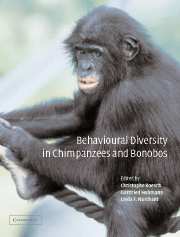Book contents
- Frontmatter
- Contents
- List of contributors
- Preface
- Behavioural Diversity in Pan
- PART I BEHAVIOURAL FLEXIBILITY
- PART II SOCIAL RELATIONS
- PART III FEMALE STRATEGIES
- INTRODUCTION
- 11 Why female bonobos have a lower copulation rate during estrus than chimpanzees
- 12 Social relationships between cycling females and adult males in Mahale chimpanzees
- 13 Seasonal aspects of reproduction and sexual behavior in two chimpanzee populations: a comparison of Gombe (Tanzania) and Budongo (Uganda)
- 14 Costs and benefits of grouping for female chimpanzees at Gombe
- 15 The cost of sexual attraction: is there a trade-off in female Pan between sex appeal and received coercion?
- PART IV HUNTING AND FOOD SHARING
- PART V GENETIC DIVERSITY
- Index
12 - Social relationships between cycling females and adult males in Mahale chimpanzees
Published online by Cambridge University Press: 08 February 2010
- Frontmatter
- Contents
- List of contributors
- Preface
- Behavioural Diversity in Pan
- PART I BEHAVIOURAL FLEXIBILITY
- PART II SOCIAL RELATIONS
- PART III FEMALE STRATEGIES
- INTRODUCTION
- 11 Why female bonobos have a lower copulation rate during estrus than chimpanzees
- 12 Social relationships between cycling females and adult males in Mahale chimpanzees
- 13 Seasonal aspects of reproduction and sexual behavior in two chimpanzee populations: a comparison of Gombe (Tanzania) and Budongo (Uganda)
- 14 Costs and benefits of grouping for female chimpanzees at Gombe
- 15 The cost of sexual attraction: is there a trade-off in female Pan between sex appeal and received coercion?
- PART IV HUNTING AND FOOD SHARING
- PART V GENETIC DIVERSITY
- Index
Summary
INTRODUCTION
Unlike the majority of mammals, anthropoid primate societies are typically characterized by the formation of constant heterosexual groups (e.g. Hrdy & Whitten 1987; van Schaik & Kappeler 1997). However, individuals in a group do not interact with all members equally. Theoretically, it is expected that individuals cooperate according to the degree of shared genes (Hamilton 1964), and, in general, individuals form affiliative relationships with kin. After sexual maturity, individuals have no choice but to form heterosexual affiliative relationships with non-kin because the individuals of one or both sexes transfer from their natal group.
Some studies have found that affiliative relationships are formed between males and estrous females, and lasting pair bonds between the sexes also exist. To begin, it is useful to distinguish between two kinds of affiliative relationships using the terms ‘short-term bonds’ and ‘long-term bonds.’ The duration of these bonds, or the ‘term,’ is often determined by events that disrupt the female's reproductive state, such as births or demographic changes in the composition of the unit groups. The short-term bond refers to a sexual relationship formed by complementary interactions, typically encompassing a mating season or several estrous cycles. In contrast, long-term bonds are formed by mutual interactions, lasting through the mating season and lactating period, and often extending over several years. ‘Friends’ in anubis baboons (Papio anubis), ‘particular proximate relationships’ in Japanese macaques (Macaca fuscata), and similar relationships in rhesus macaques (Macaca mulatta) are well-known examples of long-term bonds (Smuts 1987; Takahata 1982a,b; Chapais 1983a,b,c).
- Type
- Chapter
- Information
- Behavioural Diversity in Chimpanzees and Bonobos , pp. 168 - 180Publisher: Cambridge University PressPrint publication year: 2002
- 11
- Cited by

